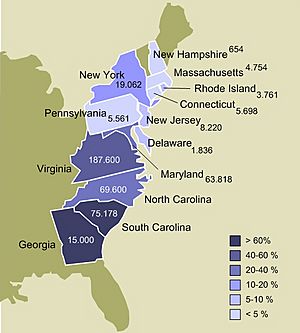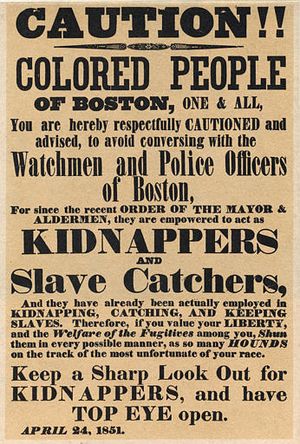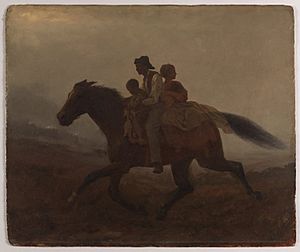Fugitive slave laws in the United States facts for kids
The fugitive slave laws were rules made by the United States Congress. These laws were passed in 1793 and 1850. Their main goal was to force the return of enslaved people who had escaped from one state to another.
The idea for these laws came from the Fugitive Slave Clause in the U.S. Constitution. This clause said that escaped enslaved people "shall be delivered up" to their owners. Some people felt that forcing states to return enslaved people went against their states' rights. They believed states should decide such matters themselves. The Compromise of 1850 included new laws. These laws allowed slavery in new territories. They also made officials in free states hold hearings for slave-owners without a jury.
Contents
Early Rules and Attempts
Even before the United States was formed, some colonies had rules about returning escaped enslaved people. In 1643, the New England Articles of Confederation included such a rule. It said that if a "servant" (meaning an enslaved person) ran away, they should be returned to their owner.
As the colonies grew, slavery spread. This led to more laws about returning enslaved people. After the United States became independent, leaders tried to create a national rule.
First Attempts in the 1780s
In 1784, a plan for new U.S. territories was made. It was called the Land Ordinance of 1784. This plan first included a rule to ban slavery after the year 1800. But this part was removed before the law was passed.
In 1785, a leader named Rufus King tried again. He wanted to ban slavery in new territories. To get support, he added a rule. This rule said that if an enslaved person escaped into these new territories, they could be taken back. This was the first time a "freedom seeker" rule was suggested in U.S. law.
Northwest Ordinance of 1787
In 1787, Congress passed the Northwest Ordinance. This law was for the Northwest Territory. It seemed to outlaw slavery there. However, it also included a rule for returning escaped enslaved people. This rule was similar to what Rufus King had suggested. It said:
"Any person escaping into the same, from whom labor or service is lawfully claimed... such fugitive may be lawfully reclaimed and conveyed to the person claiming his or her labor or service."
This meant that even though slavery was supposedly banned, enslaved people who escaped to this territory could still be forced back into slavery. Slavery continued in practice in some parts of this territory for many years.
Fugitive Slave Act of 1793
In 1793, Congress passed a law called "An Act respecting fugitives from justice, and persons escaping from the service of their masters." It is better known as the Fugitive Slave Act of 1793. This law was made to protect the property rights of slave owners. The U.S. Constitution said the federal government should help return escaped enslaved people. This 1793 Act was how they did it. It allowed the government to pursue escaped enslaved people in any state or territory.
The law stated that if an enslaved person escaped, their owner could seize them. The owner could then bring proof to a judge. The judge would then order the enslaved person to be returned.
The law also made it a crime to help an enslaved person escape. Anyone who helped could be fined $500. This was a lot of money back then.
This law put many free Black people at risk. Even if they had papers proving they were free, they could be kidnapped. They were often sold into slavery in the South. Historians believe thousands of free Black people were captured this way.
Response to the 1793 Act
Over time, some northern states passed "personal liberty laws." These laws tried to make it harder to enforce the 1793 Act. For example, Indiana (1824) and Connecticut (1828) allowed jury trials for escaped enslaved people. New York and Vermont later gave them the right to a jury trial and lawyers.
Many people were unhappy with the 1793 law. They started helping Black people escape from the South to Canada or New England. This secret network was known as the Underground Railroad.
In 1842, the Supreme Court ruled in Prigg v. Pennsylvania. The Court said that states could not be forced to help in fugitive slave cases. But it also said that the national government *must* carry out the law. After this, states like Massachusetts, Vermont, Pennsylvania, and Rhode Island passed laws. These laws stopped state officials from helping enforce the 1793 Act. They also refused to use state jails for escaped enslaved people.
Fugitive Slave Act of 1850
The South wanted a stronger law. So, in 1850, a new fugitive slave law was passed. This was part of the Compromise of 1850. This new law was much harsher.
Here are some key points of the 1850 Act:
- Special commissioners were appointed to handle cases.
- Escaped enslaved people could not speak in their own defense.
- There was no right to a jury trial for them.
- Marshals (law officers) who refused to enforce the law could be punished.
- People who helped enslaved people escape also faced penalties.
- Commissioners were paid $10 if they ruled in favor of the owner. They only got $5 if they ruled in favor of the escaped person. This made it seem like they were encouraged to send people back to slavery.
- Only the owner's word was needed as proof.
This harsh law caused many problems. It made more people become abolitionists, who wanted to end slavery. The Underground Railroad became even more active. Many northern states passed new personal liberty laws. These laws tried to protect escaped enslaved people. For example, Wisconsin's Supreme Court even said the 1850 Act was unconstitutional.
These state laws angered the Southern states. They used them as a reason to leave the Union later. Several famous cases under the 1850 law, like those of Shadrach Minkins and Anthony Burns in Boston, caused great anger. These events helped lead to the Civil War.
Fugitive Slaves During the Civil War
When the Civil War began, the legal status of enslaved people changed. In 1861, General Benjamin Butler declared that enslaved people who came to Union lines were "contraband of war." This meant they would not be returned.
In August 1861, the Confiscation Act of 1861 was passed. It freed any enslaved person who was used to help the Confederate army. Then, on March 13, 1862, Congress passed the Act Prohibiting the Return of Slaves. This law said that any enslaved person of a disloyal owner who reached Union territory was immediately free.
However, the Fugitive Slave Law still applied to enslaved people from border states. These were states that stayed loyal to the Union. It was not until June 28, 1864, that the Fugitive Slave Act of 1850 was completely ended.
See also
- Slave Trade Acts
- Turner Chapel (Oakville)
fr:Fugitive Slave Act




